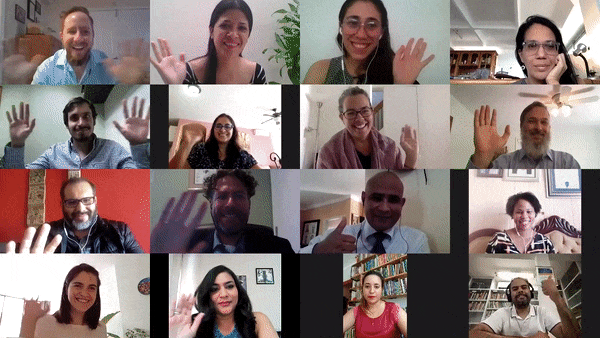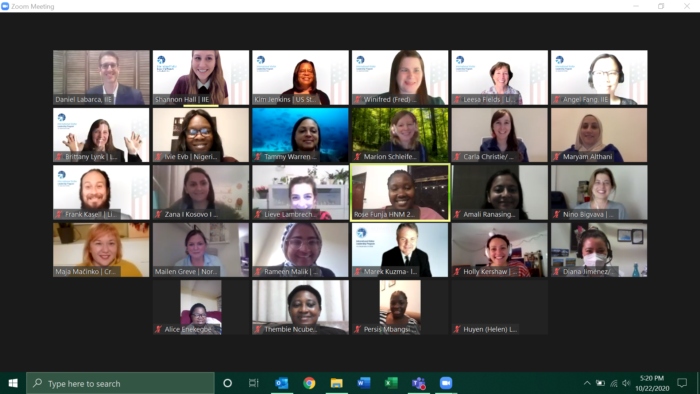By Sarah Gonzales, Program Officer, Office of International Visitors

International visitors wave hello during. Photo provided by the Office of International Visitors.
Time to Reflect
Last year, the U.S. Department of State celebrated the 80th anniversary of the International Visitor Leadership Program (IVLP) with partners around the world, such as Global Ties U.S. Anniversaries are moments when we take stock and consider whether we’re on the right path. So are crises. Over the past year, the global pandemic forced us to reimagine and recreate IVLP programming in the virtual world.
The Virtues of Virtual Programs
As we plan to resume a limited number of in-person programs over the coming months, now is a good time to consider what we have learned from virtual IVLPs and what role they can play in supporting U.S. foreign policy objectives and embassies going forward.
While virtual meetings are no substitute for in-person interactions, they can be a valuable alternative and supplement to traditional programs in an era of continuing pandemic travel constraints.
During the pandemic, U.S. embassies discovered the unexpected benefits of how virtual programs enable them to address specific country priorities. For example, small embassies previously might have nominated only a handful of annual visitors, with the majority of their allocation going towards multi-regional and regional programs. With virtual, embassies are free to identify many more participants and design single country programs tailored to meet the specific goals of the bilateral relationship.
Virtual programs also enable embassies to recruit an even more diverse body of participants that gives them access to a broader host-country network and more varied perspectives. Parents with young children, high-ranking government officials and busy CEOs, women whose culture discourages travel without a chaperone, workers who cannot afford to miss work, and residents of areas unable to travel for logistical or security reasons are just a few of the valuable groups who might be unable to commit to a three-week journey, but have joined virtual programs with enthusiasm.
Finally, virtual programs facilitate ongoing engagement with alumni. During the pandemic, we’ve engaged almost 2,000 IVLP alumni in projects on critical themes such as media responsibility in the age of COVID, countering the pandemic-related increase in domestic violence, and more. Apart from such IVLP projects, Community-Based Members (CBMs) have been generous with their time and networks by proactively organizing events for past visitors to their cities. These programs allow alumni to develop an understanding of the United States, and U.S. embassies to nurture relationships among leaders who will be key to the future of bilateral relations.

IVLP virtual exchange participants and program implementers take a group photo. Photo provided by the Office of International Visitors.
Adapting to Change
Our pivot would not have been possible without the resourcefulness and collaborative spirit of all who work on the IVLP, including the Office of International Visitors, National Program Agencies, CBMs, interpreters and liaisons, and Global Ties U.S.
The pandemic forced all of us in the international visitor programming community to innovate in order to deliver a rewarding virtual exchange experience for participants. Rethinking the Broadway shows, home hospitality, and volunteer opportunities that make our traditional IVLPs so memorable, we created event lineups that delivered valuable and engaging content that would still set the stage for lasting partnerships and cultural understanding.
Resourceful tour operators delivered virtual outings in Washington, DC and other cities that many participants have praised as an entertaining and informative highlight of their programs. Generous hosts cooked their families’ favorite meals while swapping recipes, learning about visitors’ own culinary traditions, or meeting their families.
Virtual programs also compelled us to rethink our relationship with technology. After a year of experimentation, we have learned to distinguish the useful from the gimmicky. We discovered that videoconferencing platforms can streamline interpretation in multiple languages, learning management systems can help us share program documents and encourage more pre-program reading and preparation, and mobile chat applications can offer a lively and low-maintenance forum for ongoing connection among and with visitors long after a program concludes.
The Future?
That leads us to the next question, which is how we might blend both virtual and in-person experiences in a way that enhances the exchange experience, reinforces the bonds between our visitors and U.S. counterparts, and continues to support U.S. foreign policy interests.
Virtual programs might offer “book ends” to a project. Pre-program virtual sessions could introduce participants to their subject matter and each other, leaving more time to focus on experiential learning during their three-week stay in the United States. Even post-pandemic, an embassy might still request that a program be delivered entirely virtually in order to reach more participants. Post-project virtual sessions might enable program participants to stay in touch with U.S. contacts or collaborate on projects, reinforcing embassies’ longstanding efforts to build sustainable partnerships with our program alumni.
The first international visitors were professors, novelists, musicians, journalists, and artists who enjoyed individualized programs that lasted months. Their tours through the United States, with extended stops at universities or schools for collaboration with peers, may feel quaint by today’s standards. But as we look ahead, it’s fair to note that technology and virtual programs have not changed the enduring goals of the IVLP. Whether on Zoom or in person, all of us in the IVLP Network continue to build the foundations of peace and international understanding through authentic people-to-people exchanges while remaining adaptable and responsive to the policy priorities of our diplomatic colleagues representing the United States abroad.
